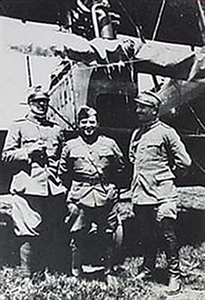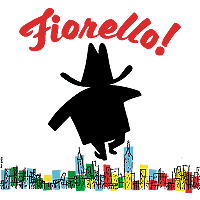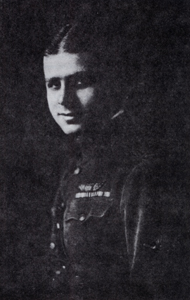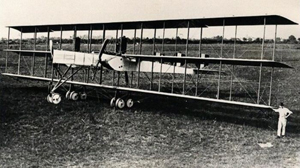When Fiorello La Guardia died in 1947, the New York Times called him “the little firebrand”—he was 5 ft. 2 in.—and “New York’s most colorful mayor since Peter Stuyvesant.” La Guardia was elected to an unprecedented three terms and served as mayor from 1934 to 1945. He wrested control of the city from the Tammany Hall political machine, which had dominated New York politics for more than 80 years. In 1934, he hefted a sledge hammer and led a search-and-destroy mission against mob boss Frank Costello’s slot machines.
He is fondly remembered for reading the Sunday comics to kids on WNYC radio during a newspaper strike in 1945. La Guardia Airport is named for him. There was even a Broadway musical, “Fiorello!” It ran for 795 performances and won the Pulitzer prize for drama in 1960.
 |
La Guardia (center) in front of a Caproni bomber in Italy.
|
But all of that came later. In 1918, he was, concurrently, a member of Congress and a captain on active duty with the Army Air Service in charge of American airmen on the Italian Front in World War I. In between his military duties, he made speeches and had dinner with King Victor Emmanuel III. He constantly upset Army bureaucrats on behalf of his airmen and more often than not, he prevailed. It seems unlikely that anyone other than La Guardia could have done it.
Fiorello (“Little Flower” in Italian) was born in 1882 in Greenwich Village in Manhattan. His father, a recent immigrant from Foggia in Italy, was a musician. He joined the Army as a band leader when Fiorello was a few months old. Fiorello grew up on Army posts, mainly Ft. Huachuca and Whipple Barracks in Arizona. When his father retired, the family moved to Trieste, where his mother had been born. Young La Guardia entered US consular service in Europe and returned to the United States in 1906 to work as an interpreter at Ellis Island by day and attend New York University School of Law by night. He eventually became deputy attorney general for the state, assigned to the New York City bureau.
In 1915, “having convinced myself that we were going to get into the war, I decided that I wanted to go into our Air Corps,” La Guardia said. A friend, Sicilian immigrant Giuseppe Bellanca, ran a small flying school at Mineola, Long Island. The trainer aircraft was a light Bleriot monoplane with a three-cylinder engine. It was a single-seater, so the student was alone in the aircraft.
Into Congress, Into War
Training began with “grass cutting” runs of about a mile and a half on the ground. The student then got out, turned the plane around, and taxied back. Once the student was able to keep the machine straight, La Guardia said, “the next step was a straightaway hop on the same course. We would lift the machine about 15 to 100 feet in the air and then land. This simple instruction went on for quite a while before we were allowed to circle the field.”
La Guardia was elected to Congress in 1916. He introduced a bill to make the fraudulent sale of war materials a felony punishable by imprisonment in peacetime and by death in time of war. It never got out of the Judiciary Committee.
When the United States entered the war, La Guardia supported the administration’s request for a military draft. “I had told the young men in my district that if I should vote for putting them into the Army, I would go myself, and personally I was eager to get into action,” La Guardia said. “I was 34 years old, physically fit, but too short to become a foot soldier. Whatever further war measures might be needed could easily pass the House without my vote. So I was ready to go to the front and determined to do so.” In July 1917, he applied for a direct commission.
He saw no reason to resign from Congress. Some members who joined the military did resign their seats; others did not. “I felt it would be good for Congress and good for the Army to have some of us serving abroad,” La Guardia said.
As he told the story in his memoirs, he put nothing on his application blank to indicate he was a member of Congress. The officer who interviewed him was “impressed by the fact that I had some little flying training,” he said, and offered him a commission as a lieutenant. A few days later, he reported to the Aviation Section of the Signal Corps and was taken to see Maj. Benjamin Foulois, soon to be chief of air service for the American Expeditionary Force.
Foulois “asked me if I was related to Congressman La Guardia,” he said. “I asked him if that would make any difference one way or the other. ‘No, not at all,’ he said.”
Foulois knew, of course, exactly who La Guardia was. A contingent of 150 aviation cadets was to be sent to Italy for pilot training. The United States had only 26 pilots and a few military airfields. Most training had to be done abroad, in France, Britain, and Italy. By amazing coincidence, the site chosen for training in Italy was Foggia, which was La Guardia’s father’s hometown.
La Guardia was assigned to Mineola, where the cadets were being assembled for overseas deployment. He was promoted to captain and assistant to the contingent commander.
 |
The logo for the Pulitzer prize-winning Broadway play based on La Guardia’s life |
One of La Guardia’s first tasks in Mineola was to make travel arrangements. The War Department order specified use of “any passenger liner sailing from the port of New York.” La Guardia booked 156 first class passages on the Cunard liner SS Carmania. He took the position that he had helped shape the law that created the cadets and knew that the intent of Congress was to provide them first class passage. The ship left New York Sept. 11.
“Our boys soon took over the ship and were running all over the decks,” La Guardia said. The colonel in command of all Army personnel aboard was furious and ordered the cadets sent down to steerage because they were not yet officers. Fiorello took exception, arguing that they had first class tickets and the status of commissioned officers.
“It came out that I was a member of Congress,” he said. The colonel continued to fume, but “we managed to win the argument,” La Guardia said.
When the ship docked in Liverpool, there was a change of plans. The cadets were sent to British flying schools, and La Guardia went to Paris, where he met a different group of 125 cadets and took them by train to Foggia, about 150 miles southeast of Rome. La Guardia’s detachment arrived Oct. 17. Forty-six American cadets were already there, under command of Maj. William Ord Ryan and training as pilots on Farman biplane pushers. La Guardia was the second-ranking American officer at Foggia.
Unfortunate Happenings
World War I on the Italian Front was often forgotten, lacking the scope and intensity of the Western Front. The Italians had declared war on Austria-Hungary in 1915 and used their Caproni trimotors to bomb Austrian airfields, roads, and railways. The Americans had been settled in at Foggia only a short time when the Italians were defeated and pushed back by the Germans and Austrians in the Battle of Caporetto in November. Reinforced by the British and French, the Americans established and held a line along the Piave River in northern Italy near Venice.
“There can be no doubt that Caporetto caused panic in Italy,” La Guardia said. The Minister of Finance told him that “within the Cabinet there was a strong feeling that a separate peace might be necessary.” From that point on, La Guardia’s diplomatic skills, his ties to Italy, and his status as a member of Congress took on special importance.
“He went to Italy at the time of the unfortunate happenings of Caporetto last fall,” the New York Times said later. “President Wilson and the United States could not have chosen a better representative in Italy than this brave soldier. On many occasions, La Guardia has spoken to the King, to soldiers, and to the people of Italy, in ammunition factories, in the trenches of the Piave, and elsewhere. … La Guardia’s achievements in Italy have gained the admiration, the praise, and the gratitude of the entire nation, from the King down.”
Between Sept. 28, 1917, and June 25, 1918, a total of 406 US pilots graduated at Foggia. They were known as “the Foggiani,” and sometimes as “Fiorello’s Foggiani” in honor of their flamboyant leader and champion.
In January 1918, the students at Foggia were divided into two camps. Ryan kept overall command and was head of one of the camps, with LaGuardia in command of the other. Before long, La Guardia again riled the chain of command, this time over food.
The rations provided for students were meager: dark black bread for breakfast, “a boiled macaroni paste” at noon, gruel or soup in the evening, and “a diminutive piece of boiled meat” once a week, La Guardia said. “I did not see how we could keep Americans, used to our diet, healthy on that kind of food.” He arranged for a caterer to provide well-balanced meals, with meat or fish every day. Major Ryan was doubtful of the authority to do this, so La Guardia signed the contract.
 |
Lt. Willis Fitch, one of the original Foggiani. Fitch later became the first executive director of the Air Force Association.
|
In due time, La Guardia was ordered to report to an outraged general in the Chief Quartermaster’s office in Tours, France. The general told La Guardia he was going to charge him with violating the law, disregarding Army regulations, and squandering public funds.
The general kept citing Army regulations. La Guardia said regulations could be changed. The general said that would take an act of Congress. “Well, I can get an act of Congress,” La Guardia said. When the general learned that La Guardia was a member of Congress, the atmosphere changed. “For the first time since I had come into the room, he asked me to be seated,” La Guardia said. “We parted as friends.” From Tours, La Guardia went to see the head of the Interallied Finance Commission, which worked out a plan for paying for the meals.
La Guardia was equally ready to challenge Italian authorities when the need arose, as it did in 1918 over problems with the SIA-7B biplane, which the United States had ordered from Societa Italiana Aviazone, an affiliate of the Fiat motor car firm. It was one of several airplanes used for training at Foggia.
Student pilots began with the French Farman MF.11 “Shorthorn,” a biplane with pusher propellers. It had tandem cockpits but no windscreen, so student and instructor were exposed in the slipstream from the waist up. After his solo in the Farman, the student was rated a military pilot and commissioned a second lieutenant. About 50 of the graduates went on to train in aerial gunnery and become pursuit pilots, but that program faltered because of a shortage of aircraft and other reasons. Follow-on training for bomber pilots was more successful.
Caproni Training
Initially, the new pilots were given a choice between training in the big Caproni bomber or the new, nimble-looking SIA-7B reconnaissance bomber. Naturally, most of them picked the SIA. The United States had ordered a number of the latest SIAs, which offered increased speed and efficiency—but which had a reputation for structural troubles. Several test pilots had been killed. The first American to fly a SIA at Foggia was also killed when the airplane buckled under him.
La Guardia declared the SIAs to be “junk” and suspended training. “I informed the Italian factory making them that we did not care to receive any more of them at Foggia,” he said. He made his decision stick, despite the protests of the company and the Italian government. The United States took the planes already on hand but canceled the rest of the order.
The rest of the Foggiani trained in various models of the three-engine Caproni bomber.
Caproni pilots could go on to complete the bombardment course at Foggia, and 131 of the Foggiani did so. Administrator-student La Guardia began his own training in the Caproni in October 1917 but did not finish until the middle of March 1918 because so much of his time was taken by administrative duties.
In February 1918, La Guardia was designated to represent the United States in dealing with Italy on aircraft contracts. Ryan was reassigned to France in June, and La Guardia, operating from an office in Rome, was responsible for both training and procurement. He was still a captain, without enough rank to be in charge of all Air Service officers in Italy, but he did not let that bother him.
 |
|
Most American pilots trained in Italy were sent to France for service with the AEF, but a detachment of about 75 remained under command of La Guardia and flew missions with the Italian air force. Among them was Lt. Willis S. Fitch, one of Fiorello’s original Foggiani, who went on to become the first executive director of the Air Force Association, 1946-47, and the first peacetime editor of Air Force Magazine.
The first American bomber pilots left Foggia for the front on June 15. They were attached to Italian bomber squadrons at Padua, Verona, and Aquila to gain experience and augment understrength units. After flying four or five missions with experienced Italian pilots, they were given command of a CA-450 or CA-600 and an Italian combat crew.
King Victor Emmanuel III came to Padua to visit the airmen and had La Guardia as his dinner guest at a former monastery near the front. They conversed easily in both Italian and English. La Guardia divided his time between Padua and duties in Rome. He was promoted to major Aug. 8, and managed to fly five combat missions in the Caproni in September. His total combat time logged was 10 hours and 20 minutes.
La Guardia returned to the United States in October. “After it looked certain that the German collapse was only a matter of weeks, I was ordered home on some military planning mission, which proved unnecessary because of the impending victory,” he said.
As the war ended, US pilots on the southern front were withdrawn and the combat division headquarters was closed Nov. 19. Eighty American pilots served with the Italians. The greatest number at the front at any one time was 58. They took part in 65 missions and flew 587 hours of combat operations.
La Guardia was re-elected in November. He resigned his commission, went back to Congress, and served until 1932. La Guardia was elected mayor of New York Jan. 1, 1934 and began his long and successful run at City Hall.